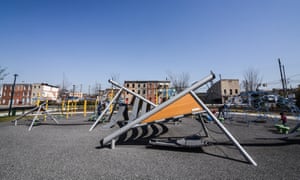↑ Some cities have turned to ‘rightsizing’, or shifting their focus from returning to their historical peak and instead toward improving life for the remaining residents. Photograph: Cebas/Getty Images/iStockphoto
Nostalgia is not a good guide to managing change. This article points to ways how cities can proactively re-invent themselve and “rightsize” … to address the economic and demograpghic shifts that would otherise lead to passive “downsizing”.
by Matt Krupnick – 13 Feb. 2020
How America’s shrinking cities can ‘rightsize’
At least 80 US cities are shrinking in population but some have found strategies to still improve the quality of life for those who stayed
A community never wants to be known as a “shrinking city” these days, no matter what the numbers say about how many people have moved away and how many old factories or homes are vacant, weeds and trash having taken over properties that once marked important industrial centers.
Although most US cities in that predicament have gone to great lengths to avoid admitting shrinkage publicly, with many branding themselves as “legacy cities”, some have taken innovative steps to accept the new reality: that they will never return to their former glory and need to adapt to their smaller size.
“We cannot go back to where we were,” said Ivonne Audirac, an associate professor of planning and landscape architecture at the University of Texas at Arlington who has studied shrinking cities. “Let’s accept that.”
Former industrial cities such as Youngstown, Ohio; Detroit; Cleveland; and Baltimore have had decades to come to terms with population loss. Youngstown, for example, has lost about 100,000 residents since 1960, while Detroit has lost more than a million in the past 70 years.
At least 80 US cities with 50,000 or more residents are shrinking, according to Cleveland State University researchers; nearly all of those cities are clustered in the rust belt area of the north-east. It’s difficult to put that figure in historical perspective because of changes in household sizes and housing availability, experts said.
Some cities have turned to “rightsizing”, or shifting their focus from returning to their historical peak and instead toward improving life for the remaining residents. Sometimes that means turning to drastic measures, such as eliminating services to largely empty neighborhoods or demolishing thousands of buildings.
Those decisions are fraught with racial and class considerations, making it difficult to find consensus among decision-makers.
“You can do a lot of things, but you need local buy-in,” said Daniel Campo, an associate professor and program director of city and regional planning at Morgan State University in Baltimore.
A handful of cities have had some success achieving that achieved that buy-in:
Tear down empty houses
Baltimore had about 950,000 residents in 1950, but more than a third of its population has left in the past 70 years. Beset by vacant properties – 16,000 houses and 18,000 lots – and crime, the city has turned its planning efforts to “a graceful decline as opposed to a really awful decline”, said Chris Ryer, director of Baltimore’s planning department.

In the past few years, the city has implemented a series of dramatic policies aimed at improving its fortunes as a smaller metropolis. Among its strategies: tearing down thousands of empty houses, “the sharp knife in the drawer”, Ryer said.
The demolitions haven’t been easy, even when the homes have been empty for years. It has been challenging for the city to figure out who owns many of the buildings, Ryer said, and many of them are rowhouses, so it’s particularly difficult to knock down one without demolishing an entire block. Still, the city has averaged about 1,000 demolitions a year the past four years or so, he said.
“If you do that for 10 years, it makes a huge difference,” Ryer said.
The newly emptied lots have given Baltimore options. Some are turned into community gardens or parks, while others have given the city the opportunity to build new neighborhoods.
Take Johnston Square, home to the city jail and one of Baltimore’s poorest neighborhoods. More than half the rowhouses there were vacant, Ryer said, so the city has knocked down many of them to stimulate development, including new apartments, stores and restaurants. The city hopes to stem its decline through such projects.
“Where you are able to attract these millennials, you will be able to sustain your population,” Ryer said.
Attract tourists
New Bedford, Massachusetts

Once one of the world’s foremost whaling cities, New Bedford’s population peaked at more than 120,000 in the 1920s. A combination of factors – most notably a 1938 hurricane that devastated the area – led to a steady decline; about 95,000 people live in New Bedford today.
As with many shrinking cities, New Bedford’s policies have differed from its public message, said Justin Hollander, a professor of urban and environmental policy and planning at Tufts University who has written about New Bedford.
“The discourse was largely about, ‘Let’s reverse this trend,’” Hollander said. “But a lot of the actions they took belied that rhetoric.”
While Baltimore has focused on essentially redesigning its city to adapt to the smaller population, New Bedford has relied partly on marketing and partly on development to brand itself as a quaint, attractive New England fishing town.
The city has mixed its redevelopment strategies with its quest to become a tourist destination. Its tourism website touts “one of the oldest and most charming small zoos in the country”, as well as a whaling museum and ornate theater.
That marketing follows years of adapting to a dramatically changed economy. The city tore down some of the old textile mills that lined its waterfront, making the district more pedestrian-friendly while maintaining the practical side of the nation’s most profitable fishing port. Other mills have been turned into artist studios.
And New Bedford has created more open space by transforming empty lots created by building demolitions into small parks or by allowing neighbors to buy the lots at a reduced price in order to expand their yards.
“We’re just trying to make it clear that things are happening in the town,” said Tabitha Harkin, the city’s planning director.
More open space
Youngstown, Ohio
No article about shrinking cities would be complete without mentioning Youngstown, which has spent 60 years coping with precipitous population loss.
Once one of the nation’s steel capitals, Youngstown lost the entire industry within a few years in the 1970s. The population plummeted, leaving behind vacant property and rising crime rates.
In 2005, desperate to find a way out of the quagmire, city leaders adopted the Youngstown 2010 plan, which provided a path to rethinking Youngstown as a more vibrant smaller city rather than an empty big one. The plan described Youngstown as “a size 40 man wearing a size 60 suit”.
The blueprint envisioned more open space, less land devoted to factories and housing, and better use of the Mahoning River waterfront. The city chose to focus its early transformation on the Idora neighborhood, where 120 vacant lots were turned into parkland, gardens, farms and other open space.
The attempt to stabilize the city hasn’t been without its bumps. Some have criticized the city for focusing revitalization efforts on wealthier areas while leaving low-income neighborhoods without city services. Shrinking cities face a variety of tough decisions on how to spend limited funds, said Jessie Grogan, a senior policy analyst at the Lincoln Institute of Land Policy.
“I think we’re still trying to find the most equitable way to do that,” she said. “I don’t think anyone has figured that out.”
View original article at www.theguardian.com




Commentaires récents